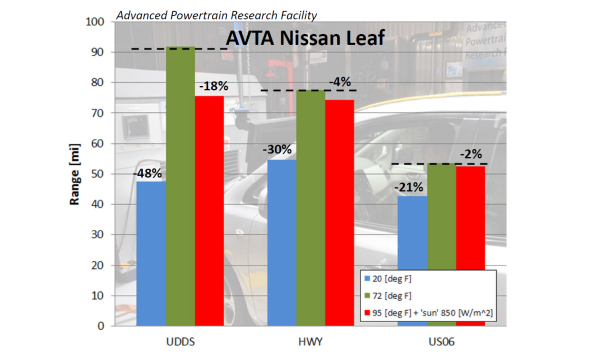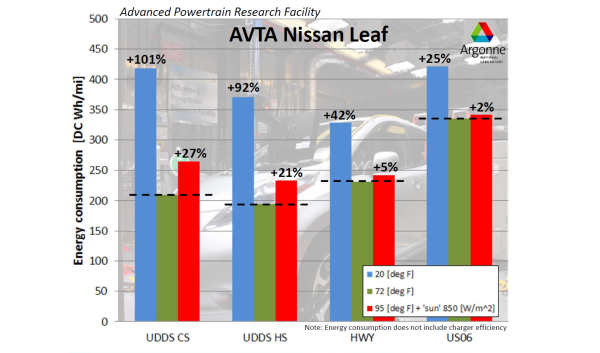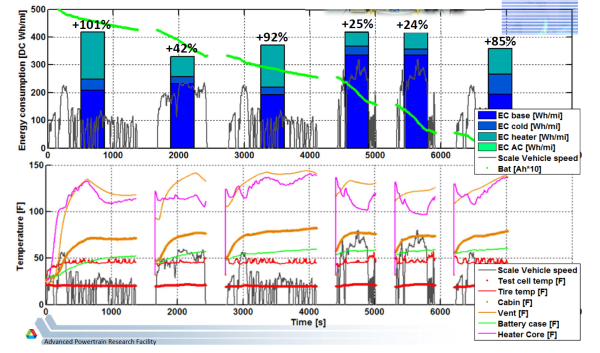The Tesla Model S Controversy: Understanding the Effects of Temperature on Electric Vehicle Efficiency and Range
by Vivek Gowri on February 18, 2013 4:22 PM EST- Posted in
- Auto
- Electric Vehicles
- Tesla Model S
- Nissan Leaf
Thermal Effects on Energy Consumption and Range
Looking at energy consumption, right off the bat, we can see that cold weather has a significant impact on EC - nearly double in urban driving, 40% more in the highway cycle, and 25% on the US06. It’s worth noting here: the Leaf has an 80 kW electric motor, a 24 kWh battery, and a 5 kW resistive heating element.
When broken down further, into a base load case (driving cycle EC at 72F), the amount of extra energy needed to drive the cycle at 20F (listed as EC cold), and then the heater load required to maintain a cabin temperature of 72F, we can see that a significant portion of the additional energy consumption is down to the heater. As with most gasoline cars, driving in sub-freezing temperatures only makes the car about 10% less efficient before heater loads are considered. The mechanically-driven heating elements in conventional vehicles add another 5% or so in terms of mechanical efficiency loss, while obviously the electric heater in the EV is far more costly from an energy consumption standpoint even though it doesn’t increase mechanical losses at all.
(Note: graphs were created by ANL using the raw 10Hz data instead of the filtered 1Hz data available on D3. Available as part of APRF's AVTA Nissan Leaf testing analysis and summary, as presented by Dr. Henning Lohse-Busch. Full presentation available here.)
And while energy consumption is a big deal, range is the be-all, end-all concern for most consumers. With the heater on, that’s a decrease in range by anywhere from 20-50% depending on your drive cycle. That’s a lot. And you can just look at the APRF’s full charge tests at 20F and 72F to see what I mean:
 Think about that - this is a car that, at launch, Nissan claimed had a 100 mile range. My own real-world driving suggests 80-85 a decent estimate. EPA says that number is closer to 73. The APRF’s instrumented testing backs that up (74.1 mile range at 72F), but the same instrumented testing, in 20F weather? 46 miles. That’s it.
Think about that - this is a car that, at launch, Nissan claimed had a 100 mile range. My own real-world driving suggests 80-85 a decent estimate. EPA says that number is closer to 73. The APRF’s instrumented testing backs that up (74.1 mile range at 72F), but the same instrumented testing, in 20F weather? 46 miles. That’s it.













102 Comments
View All Comments
alpha754293 - Tuesday, February 19, 2013 - link
Are you a mechanical engineer or an electrical engineer (by training)? Just curious.By "data cells" are you referring to data points? Or is that how many channels you're running? (2 million seems a little excessive if thats the number of channels you're running...)
I forget. Is UDDS same as FTP95?
alpha754293 - Tuesday, February 19, 2013 - link
from the car makers perspectives - a lot of traditional car makers don't really know what to do with an EV. They don't really know how to build 'em, test 'em, etc. because a lot of them aren't dependent on heavy use of steel for example (a lot of are build with aluminum and other lighter metals, some of which have not been fully characterized yet).New joining and fastening methods, new manufacturing methods -- we have a REALLY good graps of what to do with steel. We know that stuff like the back of our hands. But aluminum, and/or magnesium. pfft...it's anyone's guess at this point.
Same thing with battery/EV modeling and development. In fact, the rate that battery technologies have been changing is MUCH faster than the rate that the internal combustion engine has been changing when IT first started.
Don't be surprised if in the next few years, there's going to be a HUGE hiring phase pretty much at all of big (and small) auto makers for people with SOME (any) kind of EV experience as the need and the demand for people who know ANYTHING about EVs is going to be needed to answer some of these questions.
Right now, a LOT of them are just "tweaking" their existing procedures and methods (which are often developed from steel/ICE cars) and adapting them to "work" (barely) for EVs in their various flavours.
rikulus - Tuesday, February 19, 2013 - link
This was a very informative article, much appreciated. That a lot of energy is used to heat the car had crossed my mind, nice to see the numbers.I do get the impression from some quarters that running an electric vehicle in cold weather is inherently less efficient for the batteries. I would love to see the same test results without the heat on - not everyone needs their car set to 72 degrees. Maybe heat off, or set to 60, or just seat warmers or something.
If the loss of range is just due to how warm the car is kept, people should know that. Maybe cars could be better insulated.
name99 - Tuesday, February 19, 2013 - link
"The mechanically-driven heating elements in conventional vehicles add another 5% or so in terms of mechanical efficiency loss, while obviously the electric heater in the EV is far more costly from an energy consumption standpoint even though it doesn’t increase mechanical losses at all."Two questions:
(a) My understanding was that heating for a gasoline engine cost essentially nothing because you basically diverted hot air that was flowing over the engine into the cabin. Why do you need heating elements?
(b) Is some sort of heat pump not feasible in an electric vehicle? I honestly don't know the answer to this. Maybe, because all you have to work against is the air outside, it simply isn't feasible? (As opposed to a house, where you have the thermal inertia of the earth below the house). Or maybe the weight of the entire system, pumps and working fluid and such, makes it not a win all things considered?
pandemonium - Wednesday, February 20, 2013 - link
(a) Not to say that an electric heater is needed for a combustion engine per se, but in translation of energy consumption by comparison between combustion and electric, there's still a factor of demand on the system to get that heat to the cabin (the noted ~5%). This is the most important part of that quoted statement to focus on, "in terms of mechanical efficiency loss."(b) A heat pump - as it stands today - by itself wouldn't function correctly for an EV. There isn't anything constantly moving mechanically on an EV (transmission, wheels, drivetrain are only when the car is in motion). When the vehicle is stationary, the pump would need to draw heat from something, and given the fact that an electric motor doesn't produce much heat (especially when compared to a combustion engine), a traditional heat pump wouldn't be sufficient in this case when the vehicle is stationary. A heat pump could possibly supplement an electric heater's function by way of water->air (think radiator surrounding anything mechanical), but the effectiveness may not be worth the weight and electric energy consumption of the pump itself.
There's certainly consideration in the works for advancing heat pump elements for EVs. Example: http://arpa-e.energy.gov/?q=arpa-e-projects/electr...
cmart - Tuesday, February 19, 2013 - link
I chuckled a little when I saw that the testing went all the way down to 20F. Here in Northern MN, we average significantly colder than that for three months out of the year. Our average January temp is 11F.pandemonium - Wednesday, February 20, 2013 - link
I could definitely get used to reading automotive tech articles like this on AT. The first of hopefully many more to come! Thanks. :Djameskatt - Wednesday, February 20, 2013 - link
The Tesla needs a small gas heater to warm up the battery or cool the battery to help restore full mileage. This can be smaller than the generator needed by the Volt. Subsequently it would use a lot less gas or other fuel.Wardrop - Thursday, February 21, 2013 - link
Bring on the graphene super capacitors...http://www.youtube.com/watch?feature=player_embedd...
Steven81 - Sunday, February 24, 2013 - link
It's rather bizzare that companies that go to all the engineering lengths to built an EV still have such a big trouble in finding a fitiing way to refuel. There are only two ideas I can think of "swift recharge".One, when my phone dies I rarely charge it, it's such an inelegant way to go, instead I have precharged batteries and pop them into place (and I put the "used" battery to recharge). Something similar can well happen to these cars. Having replaceable batteries and all fuel stations would do would be to pop a precharged battery in place. Simple...
One even more elegant way would not even require fuel stations in place but would certainly need great infrastructure (which pushes it in the " not directly doable" territory). Having roads which would in essence recharge your car through your wheels' contact with them (an alternative form of the "pantograph method" that trains already use) would do the trick.
The idea that EV should be clones of the petrol cars that we use for more than a century is ridiculous at face value, and the ideas above are not even that ground breaking or hard to be thought...